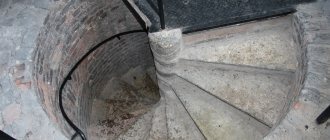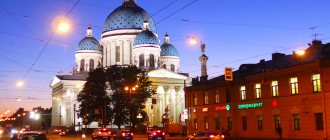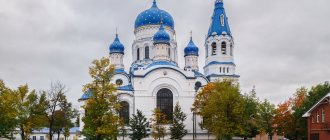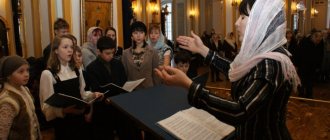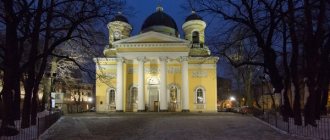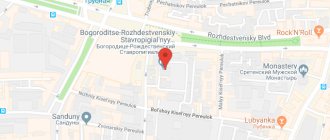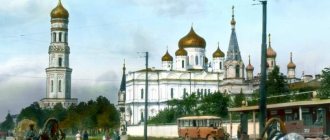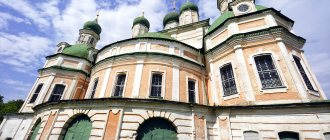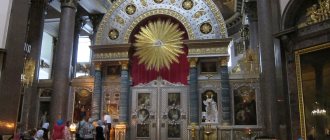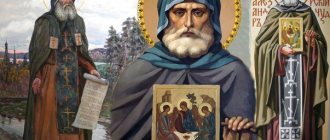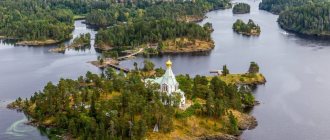I want to share with you a story about a wonderful place in St. Petersburg - the Resurrection Novodevichy Convent.
All of us, visiting new cities (towns and villages) on our travels, strive to see their “attractions”, places “worthy of note” that evoke a heartfelt response from us. When talking about churches and monasteries that preserve the sacred spirit of the locality where they are located, I immediately remember the words of Plato: “Beauty is the convincing power of truth.”
When you find yourself in the peaceful silence of a church, you suddenly begin to clearly hear the voice of your own heart. So I invite you to enjoy a similar encounter with the spiritual beauty of life by visiting the Novodevichy Convent in St. Petersburg.
History of the monastery
Novodevichy Convent is one of the largest campuses of the Northern capital. The city welcomes tens of thousands of tourists who come to see the sights. The temple is imbued with the spirit of history; there were many sad events in its fate.
Thanks to people who believed in their cause, the monastery was largely restored. Today the monastery is a unique architectural ensemble. Resurrection Novodevichy Convent is the first convent for women in the Northern capital.
Predecessors of the monastery
Empress Elizabeth I first tried to open a monastery, where she planned to spend her old age. On November 10, 1748, by her order, the construction of the Smolny Resurrection Novodevichy Convent began on the banks of the Niva River. Construction was suspended due to the ongoing war at that time. In 1764, several nuns were appointed to serve in the temple. But with their death, the monastery was abolished.
The Novodevichy Convent in St. Petersburg was founded in 1849 by Nicholas I. It was temporarily placed on the territory of Vasilyevsky Island. Then the monastery was moved again to a new location. A site for construction was allocated near the Moscow Triumphal Gate.
The state treasury allocated 25,000 rubles. per year, a lot of money was donated by philanthropists. The complex was built over five years. First of all, the wooden Kazan Church was built at that time. In 1849, construction began on the Resurrection Cathedral with five altars. It was illuminated on July 2, 1961.
Before the revolution of 1917, the monastery complex consisted of 70 nuns and 60 novices. The ensemble consisted of 8 temples and cathedrals.
Soviet period
Before the revolution, the monastery had a large farm: stables, pigsties, poultry houses, and apiaries. The workshops of the monastery were highly valued. Icons were painted here and carpets were woven. All proceeds went to the maintenance of the hospital and shelter. A lot of money was spent on charity.
When the Bolsheviks seized power, the monastery was abolished. In 1918, all valuable items were confiscated and taken away. A year later, a labor community was formed by nuns near the walls of the Resurrection Cathedral. Since 1929, churches began to close. A few years later, nuns were arrested en masse and sent into exile.
At the end of the 30s, the activities of the monastery completely ceased to exist. The damage was caused not only to people who believed in their cause, but also to the buildings of the monastery building themselves. The St. Isidore Bell Tower was blown up due to the construction of one of the main highways of the city.
The Novodevichy Convent in St. Petersburg was partially destroyed during the Soviet period
The domes of the cathedral were removed, the chapel and the stone fence were dismantled. The decoration inside the temples was completely refurbished for the Scientific Institute of Electrical Mechanical Engineering.
When Leningrad was surrounded by Nazi invaders during the Great Patriotic War, the air defense headquarters was located in the monastery building.
Revival of the monastery
In 1995, the Novodevichy Convent was restored. A year later, a small community of nuns settled near the Kazan Church. Their place of residence was an abandoned two-story building without water or heating.
The nuns, despite difficulties, conquered all the buildings that once belonged to the monastery. The first of the churches to return was the Kazan Cathedral. Over time, the remaining buildings began to return.
The buildings were restored and decorated with paintings. Work is still underway at the Kazan Cathedral. An almshouse and shelter for single mothers who found themselves in difficult life situations began its activities.
In St. Petersburg in 1996, on the Nativity of Christ, the restoration of the once former greatness of the Novodevichy Convent began. By the beginning of the 21st century, all buildings of the building were returned.
Today you can visit the souvenir shop at the monastery. Here you can buy icons, small images, utensils and souvenirs depicting the temples of the Novodevichy Convent. The complex has a sewing workshop where clothes are made for church ministers, as well as to order. Visitors and guests who visit the monastery can try dishes prepared in local bakeries and canteens.
Abbess Sofia
Since 2007, Abbess Sofia (Silina Yulia Borisovna) . Mother was born on November 18, 1972 into a non-religious family. The only believing Christian was her Cossack great-grandmother, who carried her faith through all persecution and prohibitions.
Abbess Sofia (Silina Yulia Borisovna)
In her youth, the girl Julia began to think about the meaning of life and visit the temple. The parish priest became her mentor and friend. Already a student at the Faculty of Law at St. Petersburg State University, Yulia communicated with monks and received a blessing to become a monk.
In 1992, the future abbess entered the Resurrection Novodevichy Convent as a novice. Four years later, she took monastic vows and the name of the holy martyr Sophia of Rome. Today she leads the life of a huge monastery - both its material and spiritual sides.
“I always dreamed of having at least ten children,” says the abbess, “and God gave me much more. Now I have both small and big children.”
Monastery architecture
The Novodevichy Convent in St. Petersburg faces Moskovsky Avenue. The body and cells on top resemble the letter “P”. The Resurrection Cathedral is located in the center of the monastery building.
It is the main pride of the monastery. It was built according to the architectural prototype of the Nikolaev military almshouse, located in the village of Izmailovo near Moscow. The buildings are located on the southern and northern sides of the cathedral.
The main architectural style for the buildings of the building is pseudo-Russian. The two-story monastic cells have windows framed by a Russian-style arch. The monastic buildings are separated by the Ascension Cathedral and churches. The Temple of the Three Saints is located on the northern part, and on the south is the Church of Athos.
The unified architectural ensemble was supplemented by the Kazan Church at the beginning of the 20th century. It stands out a little from the general background of the monastery, as it has distinctive architectural and stylistic features.
Shop
The Bible, lives of saints and other Christian books, as well as candles, images, crosses, chains, body icons and utensils can be purchased in the shop. They also sell things made by the sisters’ hands: textiles, souvenirs, honey.
The shop is open:
- on weekdays and Sundays from 10.00 to 19.00;
- on Saturday and on the eve of holidays from 10.00 to 18.00.
Products can also be purchased in the online store.
View of the Kazan Church from the cemetery
Monastic churches
On the territory of the monastery there are churches and chapels that are unique in their architecture.
Resurrection Cathedral
The Resurrection Cathedral is the pride of the Novodevichy Convent in the Northern capital. The temple of five chapters is built on two floors and is made in Byzantine architectural design. It took 12 years to build, the project belongs to Nikolai Efimov. The main entrance of the church is topped with a high portal in the form of an arch.
Columns adorn the façade on both sides of the church. The drums are elongated and contain five domes covered in golden color. The belfries are located under small domes.
In the temple you can see a five-tiered iconostasis, made in the shape of a semicircle. Artists belonging to the monastery, as well as the nuns themselves, painted the walls and vault and designed the images.
Cell churches
The monastic buildings are separated from the main temple by two identical churches. On the north side is the Church of the Three Saints, and on the south is the Church of Athos.
The temples were built according to the designs of N. Efimov and N. Sychev. The foundation stone of the Athos Church was made in 1850. It was built over four years. On July 28, the temple was consecrated in a solemn ceremony, where the daughter of Nicholas I, Maria Nikolaevna, was present. The temple made of stone could accommodate a hundred people. In terms of its interior design and architectural style, the church was unique in the entire city.
On the left, the Church of the Three Saints was erected, where the image of the Mother of God “Fragrant Flower” is located. Outwardly, it is very similar to the Athos Church. But the construction of this temple took a year longer. It was consecrated in 1855. This building was intended to serve the hospital at the temple.
Cell churches have five golden-colored domes, and the bell tower is made in the form of a tent. The roofs are painted green, arches adorn the facades of the buildings.
Cemetery Church of Elijah the Prophet
The Temple of Elijah the Prophet is located at the entrance of the necropolis. It is made of stone in the “Moscow Baroque” style. Five chapters are covered with glazed bricks. Inside the church there is a carved oak iconostasis, the decoration is rich.
Soviet authorities closed the church in 1925, and in the 1930s it was dismantled brick by brick.
Cemetery Sorrow Church
The church was erected in the center of the Novodevichy cemetery in the 50s. In the temple there was the most enchanting icon of the Resurrection of Christ in the city, which was carved from elephant bone.
It was also called the “Karamzin” church, as it was built over the burial place of the son of the writer N.M. Karamzin, the famous commander of the hussar regiment. Later his wife was interred nearby. The Soviet government closed the church in 1925, and then completely destroyed the temple along with the grave of the Karamzins.
Kazan Church
The Kazan Church was built according to the design of the Russian architect Vasily Antonovich Kosyakov. The church reflects Christian history for many centuries, it personifies Russian and Byzantine culture.
The construction of the temple was completed in 1910. The walls were lined with green marble, and the interior was painted in the ancient Russian style. At the beginning of the Great Patriotic War, the country's economy was undermined, so construction was suspended. As a result, the temple doors were closed.
After the transfer of the monastery buildings to the Mechanical Engineering Institute, the Kazan Church was used as a machine shop. The constantly running machines caused irreparable damage to the building. Only in 1992 the activity of the church was resumed.
Massive columns surround the central part of the church. The main hall of the cathedral is located in the main hall. Three carved wooden iconostases decorate the church building.
Monastery bell tower
The tall St. Isidore bell tower was erected not far from the Resurrection Cathedral. It was erected in 1985 according to the model of the bell tower of Ivan the Great. She is a graduate of the campus architectural ensemble.
Images of patrons and inscriptions cast on the bell tower symbolized prayer for each of them with each strike of the bell. At the end of the 20s, the monastery bell tower was blown up - Moskovsky Avenue was expanded.
Devotees of the monastery
After the civil war that occurred in 1917, the cross was removed from the dome of the Kazan Cathedral. During the First World War, during the siege of Leningrad, shells hit the church building, but after the war it was repaired and restored.
But since the early 90s, services to God have been held in the temple. The Kazan Icon of the Mother of God returned to its place, and the cross again appears on the dome of the church. Every year on September 12, crusades and processions take place along Nevsky Prospect in honor of Alexander Nevsky. He is the patron saint of the Northern capital.
Devotees of the Novodevichy Convent are actively engaged in spiritual and educational activities. There is a Prince Vladimir school where the Law of God is studied. Pupils are engaged in choral singing.
The monastery operates a “Grace” shelter for single mothers whose fate is difficult. Women can stay in the shelter for an unlimited amount of time until they get back on their feet. The temple also cares for older nuns.
Women with children who have difficulties with housing and work turn to the women's shelter for help. Here they live until their curators help them solve their life problems. Single mothers live in the monastery for free, receive clothing, food, and medicine. Mentors teach them how to do housework and raise children.
The nuns who served the temple faithfully in their old age are not forgotten. The elderly and infirm sisters of the monastery live in a small almshouse. They are properly cared for by nurses and given everything they need to live.
On the territory of the monastery building there is a charitable diagnostic medical clinic . He accepts all women free of charge for examination and detection of oncological abnormalities. During this time, women who apply can later consult a doctor and eliminate the disease, since recovery is possible at an early stage.
St. Vladimir Monastery School
In 1873, the abbess of the monastery of Evstolia was allowed to open a shelter for poor children who had lost their parents and relatives. Later, with the assistance of K.P. Pobedonostsev, a school was opened here. Thanks to him, women studied at the school who later taught in church schools in the city.
After the civil war of '17, the school was closed. After 80 years, the building resumed its activities as a Sunday school. The opening was blessed by the abbess of the monastery Sofia.
Currently, there are about a hundred students studying here, many of them from low-income families. In addition to studying the Law of God and choral singing, the school teaches general education subjects in accordance with state education standards.
Life today
Today, the monastery has been almost completely restored. Three dozen sisters live in the monastery, about half of them are novices. In addition to the church shop and Sunday school, the monastery operates:
- general education school;
- sewing workshops;
- publishing house;
- bakery and refectory;
- Pilgrim's House;
- nursing home;
- children's home.
The sisters regularly receive foreign delegations, conduct excursions around the monastery, and the choir participates in various religious events.
Novodevichy Cemetery
At the Novodevichy Convent in the Northern capital there is a cemetery of the same name. It was officially opened in 1848, although burials in the churchyard took place much earlier. The cemetery is the last monastery to this day, despite the fact that it was closed in 1834.
The cemetery is famous for the burial of famous people, heroes of the Russian-French war. Here you can find the graves of aristocrats, famous writers, composers, and artists.
After the 1917 revolution, the necropolis was abandoned and was plundered. Expensive jewelry, tombstones, and tiles were taken out of the crypts. Before these sad events, there were two churches on the territory of the churchyard: Kazanskaya and Ilyinskaya. After the civil war they were completely destroyed.
Much later, the monuments were restored and repairs and cleaning of the area began. Now the cemetery is a beautiful and well-kept graveyard.
Schedule of services 2022
During weekdays
- 6:00 – morning worship
- 17:00 – evening worship
On Saturday
- 9:00 – Divine Liturgy
- 17:00 – all-night vigil
On Sunday
- 8:40 – Akathist to Hilarion of the Trinity
- 9:30 – Divine Liturgy
- 17:00 – evening worship
Official site
vnodevichiy.rf
Telephone
8 812-252-11-66
Rules for visiting the monastery
The Novodevichy Convent in St. Petersburg is visited according to general rules. Before entering, you need to make the sign of the cross 3 times and bow. If a sign is done incorrectly or carelessly, it is considered a sin.
There are strict rules regarding clothing on the territory of the monastery:
- Women should visit the temple in skirts or sundresses.
- The head should be covered with a scarf or shawl, outerwear with long sleeves.
- Sports items are not allowed.
- Women should not use bright cosmetics.
- Men must wear trousers and shirts to services.
- Men must remove their hats before entering the temple.
The threshold of the temple must be crossed calmly, without fuss. Loud conversations and sudden movements are not welcome in church. Cell phones must be turned off so they do not interfere with the church service. You cannot turn your back to the altar.
Children should be taught from a young age to behave quietly and calmly in church. If a child is capricious and screaming, then it is better to leave the temple. You can sing along with the choir without disturbing anyone. When leaving the temple, turn to face the church and cross yourself three times.
The Novodevichy Convent has a complex and sad history. He moved and rebuilt more than once. During the difficult years in St. Petersburg, on campus, the lives of people who believed in their cause and defended their faith tragically ended. But their efforts were not in vain - now the monastery is the most important architectural and historical landmark.
Article design: Mila Friedan
